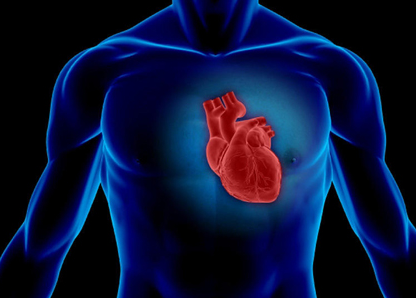So here-- I copied this from Wikipedia,
这个图我是从维基百科中拿来的
this diagram of the human circulatory system-- and here in the back you can see the lungs.
显示了人体的循环系统,后边这里是肺
Let me do it in a nice dark color.
我用深色标一下
So we have our lungs here. Drew them right like that. Those are lungs.
这是肺部
You can see the heart is sitting right in the middle.
大家可以看到,心脏在中间
And what we learned in the last few videos is that we have our little alveoli and our lungs.
我们之前介绍过了,这里是肺部的肺泡
Remember, we get to them from our bronchioles,
它们连接了细支气管
which are branching off of the bronchi, which branch off of the trachea,
细支气管由支气管分支形成,然后支气管又由气管分支形成
which connects to our larynx, which connects to our pharynx, which connects to our mouth and nose.
气管连接咽喉,咽喉又到嘴和鼻子
But anyway, we have our little alveoli right there and then we have the capillaries.
这里是肺泡,这是毛细血管
So when we go away from the heart-- and we're going to delve a little bit into the heart in this video as well
远离心脏的时候,我们待会也会介绍一下心脏
so when blood travels away from the heart, it's de-oxygenated.
血液远离心脏时,是缺氧血
It's this blue color. So this right here is blood.
缺氧血用蓝色表示
This right here is blood traveling away from the heart.
这是远离心脏的血液

It's going behind these two tubes right there.
从这两条血管走
So this is the blood going away from the heart.
这是远离心脏的血液
So this blue that I've been highlighting just now, these are the pulmonary arteries
刚用蓝色标注的,这是肺动脉
and then they keep splitting into arterials and all of that and eventually we're in capillaries-- super, super small tubes.
之后分成一系列动脉,最后来到毛细血管,也就是非常非常细的血管
They run right past the alveoli and then they become oxygenated and now we're going back to the heart.
通过肺泡,血液补充了氧气,再回到心脏
So we're talking about pulmonary veins.
通过肺静脉
So we go back to the heart.
回到心脏
So these capillaries-- in the capillaries we get oxygen.
在这里的毛细血管,血液补充了氧气
Now we're going to go back to the heart.
然后回到心脏
Hope you can see what I'm doing.
希望大家能看清楚我标注的
And we're going to enter the heart on this side.
血液从这里回到心脏
You actually can't even see where we're entering the heart.
实际上大家应该看不到进入心脏的位置
We're going to enter the heart right over here-- and I'm going to go into more detail on that.
我们从这里进入心脏,之后我们再详细介绍
Now we have oxygenated blood. It's red.
现在血液是含氧血,用红色标注
And then that gets pumped out to the rest of the body.
然后被运送到身体各处
Now this is the interesting thing.
这是有意思的地方
When we're talking about pulmonary arteries and veins-- remember, the pulmonary artery was blue.
因为刚我们说到了肺动脉和肺静脉,注意,肺动脉是蓝色的
As we go away from the heart, we have de-oxygenated blood, but it's still an artery.
离开心脏的时候,是缺氧血,却是在动脉里
Then as we go towards the heart from the lungs,
然后从肺部回到心脏的血液
we have a vein, but it's oxygenated. Let me write that down.
是含氧血,通过静脉运送的,我写一下
I wrote that in the last video. But pulmonary- so the pulmonary artery, no oxygen.
上集我们也介绍过,肺动脉输送的没有氧气
Or maybe i shouldn't write that. I should write deoxygenated.
应该说是缺氧血
Because there might be some oxygen. Deoxygenated.
因为可能还是有一点氧气的
And then the pulmonary vein, it has oxygen.
而肺静脉中的血液,是含有氧气的
So that's this little loop here that we start and I'm going to keep going over the circulation pattern
这就形成了一个循环,我尽量介绍清楚循环的模式
because the heart can get a little confusing,
因为这是三维图
especially because of its three-dimensional nature.
在心脏的部分,可能会容易混淆












